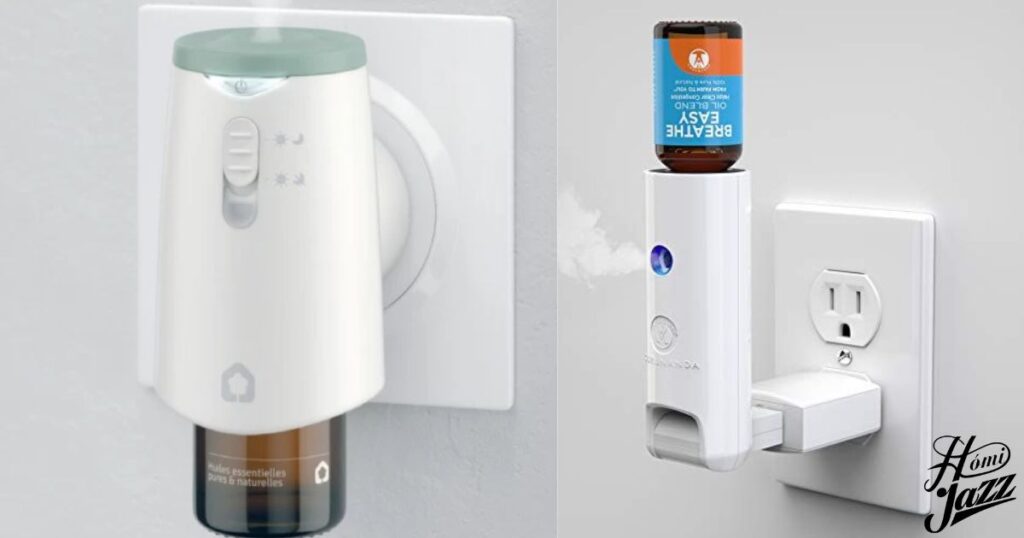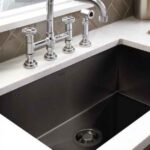Creating a pleasant home environment can feel like an endless task. Many traditional air fresheners contain harsh chemicals, while natural alternatives like candles pose safety risks and require constant monitoring.
The search for an effective, safe, and low-maintenance fragrance solution often leads to frustration and wasted money. Plug in oil diffusers offer a practical solution to these common challenges.
These devices provide continuous fragrance without open flames, harmful chemicals, or constant refilling. Modern plug in diffusers combine essential oils with innovative warming technology to deliver consistent scent coverage while addressing safety and maintenance concerns.
Understanding Plug In Oil Diffusers

What is a Plug In Oil Diffuser?
A plug in oil diffuser is a simple device that releases fragrance into your home through a wall outlet. These compact units transform liquid fragrance into a gentle scent using basic warming technology.
The modern plug in oil diffuser has evolved significantly since its introduction in the 1990s. Today’s models feature adjustable settings and use high-quality essential oils for a better fragrance experience.
Unlike traditional air fresheners, these devices provide consistent scent coverage throughout the day without requiring batteries or constant maintenance.
How Plug In Oil Diffusers Work
The plug in oil diffuser operates through a straightforward warming system. When plugged in, a small ceramic heating element warms to approximately 150°F (65°C).
The heat activates the fragrance oil, which travels up through a specialized fiberglass wick. This wick controls how quickly the oil evaporates into the air. The 5-watt heating element ensures safe operation while maintaining optimal temperature for fragrance release.
Most modern units include a built-in thermostat to prevent overheating and maintain consistent performance.
Types of Plug In Oil Diffusers

In 2024, plug in oil diffusers come in several distinct styles. Basic models feature a simple on/off function and standard heating element. Mid-range units include adjustable intensity dials to control fragrance strength.
Premium diffusers offer digital controls, timer functions, and smart home compatibility. Some newer models also feature built-in night lights or decorative LED displays.
The most advanced units allow you to pair multiple diffusers through smartphone apps for whole-home fragrance control. Each type uses standard refill bottles, making them convenient for regular use.
Benefits and Applications
Therapeutic Advantages
Plug in oil diffusers release essential oils that support health and well-being. These devices help reduce stress and promote better sleep. Many users report improved mood and mental clarity when using lavender or chamomile oils.
The controlled release of oils can ease headaches and congestion. Recent studies in 2024 show that certain essential oils may boost immune system function.
The steady diffusion helps maintain consistent therapeutic benefits throughout the day. Unlike candles or incense, plug in oil diffusers provide these benefits without smoke or open flames.
Commercial Uses
Businesses increasingly use plug in oil diffusers to create memorable experiences. Hotels employ signature scents to build brand recognition and enhance guest satisfaction.
A 2024 survey showed that 78% of hotel guests remember a location’s signature fragrance. Offices use energizing scents like citrus to boost productivity. Retail stores use specific scents to increase customer dwell time and sales.
These diffusers work well in commercial settings because they need minimal maintenance and provide consistent fragrance coverage.
Home Applications
Plug in oil diffusers work effectively in different rooms of your home. For bedrooms, calming scents like lavender help with sleep. Kitchen areas benefit from fresh citrus or herb scents that neutralize cooking odors.
Living rooms do well with warm, welcoming fragrances like vanilla or sandalwood. Bathrooms need stronger scents for odor control. One diffuser can cover about 200 square feet of space.
The best results come from placing diffusers near air circulation paths but away from direct sunlight. Modern plug in diffusers include adjustable settings for different room sizes.
Comparative Analysis
Plug In vs. Ultrasonic Diffusers
Plug in oil diffusers and ultrasonic diffusers operate in fundamentally different ways. The Plug in oil diffusers use a heating element to warm essential oils, releasing fragrance continuously.
They work without water and are completely silent. Ultrasonic diffusers, in contrast, create a fine mist by mixing water with oils through ultrasonic vibrations. The 2024 market data shows plug in diffusers typically cost between $5-15, while ultrasonic models range from $20-100.
Plug in units excel in consistent fragrance delivery and require minimal maintenance. However, ultrasonic diffusers offer the added benefit of light humidification and often feature adjustable mist settings.
Cost and Efficiency Analysis
In 2024, the average plug in oil diffuser uses about 5 watts of power, costing roughly $0.15-0.30 per month to operate. A standard refill contains 20ml of oil and lasts 30-90 days, depending on intensity settings.
This translates to approximately $2-4 per month in refill costs. Compared to other fragrance options, plug in diffusers prove highly cost-effective over time.
The initial investment is minimal, and the controlled release system prevents oil waste. Most units feature adjustable settings to optimize oil consumption and extend refill life.
| Cost Factor | Monthly Expense |
| Electricity | $0.15-0.30 |
| Refills | $2-4 |
| Maintenance | $0-1 |
Environmental Considerations
Modern plug in oil diffusers emphasize environmental responsibility. Current models use recyclable components and energy-efficient heating elements. The waterless operation reduces resource consumption compared to traditional diffusers.
Many manufacturers now offer natural, plant-based oil refills without synthetic additives. The small energy footprint and concentrated oil formulas minimize packaging waste and transportation impacts.
Some brands even implement refill recycling programs to further reduce environmental impact. The latest designs focus on durability, helping reduce electronic waste through longer product lifecycles.
Safety and Maintenance
Safety Guidelines
Plug in oil diffusers include built-in safety features for 2024 models. All units have automatic shut-off protection if tipped over or running low on oil. The heating elements maintain temperatures below 140°F to prevent oil degradation.
Users should place diffusers away from children and pets, keeping them plugged into ground-fault protected outlets. Avoid using pure essential oils without proper dilution, as this can damage the device and create safety risks. Regular inspection of cords and plugs ensures continued safe operation.
Maintenance Requirements
Basic maintenance keeps plug in oil diffusers working efficiently. Clean the unit monthly with a soft cloth to remove dust and oil residue. Replace fiberglass wicks every 3-4 refills to maintain optimal performance. Check heating elements regularly for proper function.
Most 2024 models feature indicator lights showing when maintenance is needed. Keep refill ports clean and sealed when not in use. Store unused refills in a cool, dark place to preserve oil quality. Simple maintenance takes just minutes per month.
Troubleshooting Common Issues
Common plug in oil diffuser problems have straightforward solutions. Weak fragrance usually indicates a worn wick or empty refill. Uneven scent distribution might require adjusting intensity settings or relocating the unit. Some models develop clicking sounds, typically resolved by ensuring proper refill installation.
If the unit stops working, check the outlet and heating element for issues. Most problems resolve through basic troubleshooting steps without needing replacement. Manufacturer support lines provide additional guidance for complex issues.
Installation and Operation
Setup Guide
Installing a plug in oil diffuser is a straightforward process. First, choose a suitable wall outlet away from curtains and furniture. Remove the oil bottle cap and insert the bottle into the warmer unit. Ensure the wick aligns properly with the heating element.
Plug the unit into the wall socket and adjust the intensity dial to your preferred setting. Most modern plug in oil diffusers come with variable settings from low to high. Start with a lower setting and adjust based on room size and desired fragrance strength. For safety, avoid touching the heating element and keep the device away from children and pets.
Read This Blog: Steampunk Decor: The Ultimate Guide to Transforming Your Space
Optimal Usage Tips
For best results with your plug in oil diffuser, placement matters significantly. Install the unit at waist height or lower, as fragrances naturally rise. One diffuser typically covers 150-200 square feet effectively. Rotate the bottle every few days to ensure even oil distribution.
When the fragrance becomes faint, adjust the intensity setting rather than replacing the bottle immediately. Most oil refills last 30-90 days depending on the setting used. Clean the unit monthly with a dry cloth when unplugged to maintain optimal performance.
Environmental Factors
Room conditions directly impact plug in oil diffuser performance. High humidity levels can weaken scent diffusion, while dry air may intensify the fragrance. Optimal room temperature ranges between 68-78°F (20-26°C) for best results.
Air conditioning and heating systems can affect fragrance distribution, so adjust diffuser settings accordingly. Avoid placing units near open windows or fans, as airflow can disrupt even scent distribution. In larger spaces, consider using multiple units spaced strategically for consistent coverage.
Also Read This Blog: Blueface House: Inside the Rapper’s Luxurious Lifestyle and Celebrity Mansion
Buying Guide
What to Look For
Key features to consider when purchasing a plug in oil diffuser include:
- Adjustable intensity settings
- Auto-shutoff functionality
- Refill indicator light
- Heat level control
- Compatibility with multiple oil brands
- Energy efficiency rating
- Safety certification (UL listed) Look for models with clear usage instructions and manufacturer warranty. The heating element should provide consistent warmth without excessive heat. Choose units with childproof features if you have young family members.
Top Recommendations
Current leading plug in oil diffuser models in 2024:
| Model | Coverage Area | Features | Price Range |
| Brand A Pro | 200 sq ft | 5 settings, LED | $15-20 |
| Brand B Max | 180 sq ft | Auto-off, Timer | $12-18 |
| Brand C Elite | 250 sq ft | Digital control | $20-25 |
These models offer reliable performance and positive user feedback for continuous home fragrance delivery.
Price Comparison
Plug in oil diffuser costs vary based on features and brand:
- Basic models: $8-15
- Mid-range units: $15-25
- Premium devices: $25-40
Operating costs average $2-4 per month for oil refills. Energy consumption remains minimal at 4-7 watts. Consider refill compatibility when choosing a unit, as some brands require specific cartridge types. Many manufacturers offer bulk refill packages for additional savings. The initial investment typically pays off within 2-3 months compared to other fragrance options.
Frequently Asked Question
Are plug-in oil diffusers safe?
Plug-in oil diffusers are generally safe when used as directed. They feature built-in safety mechanisms like auto shut-off and low-temperature heating elements. However, use only compatible oils and keep them away from children and pets. Choose high-quality diffusers from reputable manufacturers that meet safety standards.
Do plug-in diffusers work?
Yes, plug-in diffusers effectively distribute fragrance throughout a room. They use gentle heat to warm essential oils, releasing consistent aroma through a fiberglass wick. Most models can scent spaces up to 150-200 square feet.
Can you use plug-in oils in a diffuser?
Not all oils are interchangeable. Only use oils specifically designed for your plug-in diffuser model. Regular essential oils may damage the device or create safety hazards. Check manufacturer guidelines for compatible oil types.
How long do plug-in oil diffusers last?
A typical plug-in diffuser refill lasts 30-90 days, depending on intensity settings and usage. The device itself can last several years with proper maintenance. Most units include adjustable settings to control fragrance strength and longevity.
Are diffusers ok for lungs?
When used properly, plug-in diffusers are safe for most people. However, those with asthma, allergies, or respiratory sensitivities should consult their doctor. Use in well-ventilated areas and avoid overexposure.
Do plug-in diffusers use a lot of electricity?
No, plug-in diffusers are energy efficient. Most models use only 2-5 watts of power, similar to an LED light bulb. The annual electricity cost is minimal, typically less than $5 per year.
Conclusion
Plug in oil diffusers offer a practical and safe solution for home fragrance needs. They combine convenience with effectiveness, providing consistent scent distribution without the risks of open flames or harsh chemicals.
While proper usage guidelines should be followed, these devices represent a cost-effective, energy-efficient choice for creating pleasant indoor environments. Their long-lasting performance and adjustable settings make them an ideal choice for modern homes seeking reliable fragrance solutions.

Howdy is behind this home blog, sharing personal stories, thoughts, and insights from daily life. I can dedicated to bringing you the latest trends, expert advice, and creative ideas to make your home the sanctuary you’ve always dreamed of. Whether you’re looking for DIY tips, home decor inspiration, home loans, rentals or renovations.







